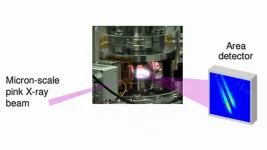(Press-News.org) ITHACA, N.Y. - Soil carbon storage, carbon capture and storage, biochar - mention these terms to most people, and a blank stare might be the response.
But frame these climate change mitigation strategies as being clean and green approaches to reversing the dangerous warming of our planet, and people might be more inclined to at least listen - and even to back these efforts.
A cross-disciplinary collaboration led by Jonathon Schuldt, associate professor of communication at Cornell University, found that a majority of the U.S. public is supportive of soil carbon storage as a climate change mitigation strategy, particularly when that and similar approaches are seen as "natural" strategies.
"To me, that psychology part - that's really interesting," Schuldt said. "What would lead people, especially if they're unfamiliar with these different strategies, to support one more than the other? Our study and others suggest that a big part of it is whether people see it as natural."
The group's paper, "Perceptions of Naturalness Predict U.S. Public Support for Soil Carbon Storage as a Climate Solution," published May 26 in the journal Climatic Change. Co-authors include Johannes Lehmann, the Liberty Hyde Bailey Professor in the School of Integrative Plant Science (SIPS), Soil and Crop Sciences Section (CALS); Dominic Woolf, senior research associate in SIPS; Shannan Sweet, postdoctoral associate in the Lehmann Lab; and Deborah Bossio of the Nature Conservancy.
Schuldt's team analyzed results from a survey of 1,222 U.S. adults who reported believing in climate change at least "somewhat," to estimate public support for soil carbon storage and how it compares to other leading carbon dioxide removal strategies.
Mitigation strategies - solar and wind power, electric vehicles and sustainable land use and biodiversity, to name a few - are already capturing much attention as the world grapples with rising temperatures, melting ice caps and increasingly violent weather events.
Survey data came from an online poll conducted Sept. 19 to Oct. 4, 2019, by NORC at the University of Chicago, a leading survey research firm. The team solicited respondents' perceptions of naturalness and policy support for five CO2 removal strategies: afforestation and reforestation; bioenergy plus carbon capture and storage; direct air capture; soil carbon storage; and soil carbon storage with biochar. Each respondent viewed a randomized group of three options and was asked to estimate the likelihood that they'd support that strategy.
They were also asked to rate their level of agreement with each of five statements related to humans' tampering with nature.
In the final analysis, perceived naturalness was a strong indicator of support for soil carbon storage as a climate change mitigation strategy. Of the five CO2 removal strategies, support was highest (73%) for afforestation and reforestation; soil carbon storage ranked second, supported by 62% of those polled.
And in this politically divided time, Schuldt said, support for soil carbon storage crossed the aisle. A total of 72% who identified as Democrats supported the strategy; among Republicans, 52% were in support.
"We expected, and found, that Democrats support all kinds of climate strategies more than Republicans do," Schuldt said. "But the error I think we sometimes make is that we categorize all Democrats as being for it, and all Republicans as being against it. That's not true."
Ultimately, Schuldt said, the goal is to allow policymakers to present the public with palatable options for addressing climate change.
"There is a whole range of solutions out there," he said. "Then the question politically becomes, where do you start? Which one has the most buy-in? I think our data help speak to that."
INFORMATION:
Funding for this research came from the Cornell Atkinson Center for Sustainability, the Nature Conservancy and the Craig and Susan McCaw Foundation.
With brilliant colors and picturesque shapes, many crystals are wonders of nature. Some crystals are also wonders of science, with transformative applications in electronics and optics. Understanding how best to grow such crystals is key to further advances.
Scientists from the U.S. Department of Energy's (DOE) Argonne National Laboratory, along with three universities, have revealed new insights into the mechanism behind how gallium nitride crystals grow at the atomic scale.
Gallium nitride crystals are already in wide use in light-emitting diodes, better known as LEDs. They might also be applied to form transistors for high-power switching electronics to make electric grids more energy efficient and smarter. The use of such "smart grids," which ...
The opioid epidemic is taking a deadly toll on people in disproportionate clusters from Cape Cod to San Diego, according to a new study by the University of Cincinnati.
Fatal opiate overdoses are most prevalent among six states: Ohio, Pennsylvania, Kentucky, West Virginia, Indiana and Tennessee. But researchers identified 25 hot spots of fatal opioid overdoses nationwide using data from the Centers for Disease Control and Prevention.
The study demonstrates how both widespread and localized the problem of substance use disorders can be, UC assistant professor and co-author Diego Cuadros ...
What is happening deep beneath the surface of ice planets? Is there liquid water, and if so, how does it interact with the planetary rocky "seafloor"? New experiments show that on water-ice planets between the size of our Earth and up to six times this size, water selectively leaches magnesium from typical rock minerals. The conditions with pressures of hundred thousand atmospheres and temperatures above one thousand degrees Celsius were recreated in a lab and mimicked planets similar, but smaller than Neptune and Uranus.
The mechanisms of water-rock interaction at the Earth's surface are well known, and the picture of ...
Modern-day agriculture faces two major dilemmas: how to produce enough food to feed the growing human population and how to minimize environmental damage associated with intensive agriculture. Keeping more nitrogen in soil as ammonium may be one key way to address both challenges, according to a new paper in the Proceedings of the National Academy of Sciences (PNAS).
Today's use of nitrogen fertilizers contributes heavily to greenhouse gas emissions, air pollution, and water pollution, but they are also essential for growing crops. Reducing this pollution is critical, but nitrogen use is likely to grow with increased food production. At ...
UNIVERSITY PARK, Pa. -- One of the most important and widespread reef-building corals, known as cauliflower coral, exhibits strong partnerships with certain species of symbiotic algae, and these relationships have persisted through periods of intense climate fluctuations over the last 1.5 million years, according to a new study led by researchers at Penn State. The findings suggest that these corals and their symbiotic algae may have the capacity to adjust to modern-day increases in ocean warming, at least over the coming decades.
Cauliflower corals -- which are in the genus Pocillopora -- are branching corals that provide critical habitat for one-quarter of the world's fish and many kinds of invertebrates, such as lobsters, sea urchins and giant clams. ...
To help patients manage their mental wellness between appointments, researchers at Texas A&M University have developed a smart device-based electronic platform that can continuously monitor the state of hyperarousal, one of the signs of psychiatric distress. They said this advanced technology could read facial cues, analyze voice patterns and integrate readings from built-in vital signs sensors on smartwatches to determine if a patient is under stress.
Furthermore, the researchers noted that the technology could provide feedback and alert care teams if there is an abrupt deterioration in the patient's mental health.
"Mental health can change very rapidly, and a lot of these changes remain hidden from providers or counselors," said Dr. Farzan Sasangohar, assistant ...
Like a good story, feeding has a beginning, a middle and an end. It begins with appetite prompting the search for food, continues with eating the food and it ends when satiation hits and the consumption of food is stopped.
At Baylor College of Medicine, Dr. Qi Wu, Dr. Yong Han and their colleagues have uncovered new aspects of the last part of this story that relate to the little-known neural circuits and neurotransmitters involved in ending food consumption.
The team discovered a novel circuit that connects a unique subset of dopamine-producing neurons with downstream neurons in the hindbrain (lower brainstem) ...
The province of Quebec is one of only a few jurisdictions to enshrine sustainable development into law. In 2006 the then-Liberal government of Jean Charest adopted the END ...
Up to half of patients with head and neck squamous cell carcinoma will experience tumor recurrence or new tumors--tumors that often spread and are difficult to treat.
A team of scientists led by the University of Michigan School of Dentistry identified a mechanism by which head and neck cancer cells subvert adjacent normal tissue, allowing small clusters of cancer cells to burrow beneath the healthy tissue.
The team decided to look at this particular mechanism in head and neck cancer because a specific gene, DMBT1, appeared on a screen of genes that are silenced during oral cancer, said principal investigator Nisha D'Silva, the Donald A. Kerr Endowed ...
ITHACA, N.Y. - Approximately one-third of all U.S. counties do not exempt grocery foods from the general sales tax, which means the lowest-income families living in those areas are most susceptible to food insecurity. New research from Cornell University finds that even a slight grocery tax-rate increase could be problematic for many.
"An increase of 1% to 4% may sound small, but after several trips to the grocery store, the extra costs can create serious burdens for the lowest-income families," said co-author Harry Kaiser, professor of applied economics and management in the Charles H. Dyson School of Applied ...




